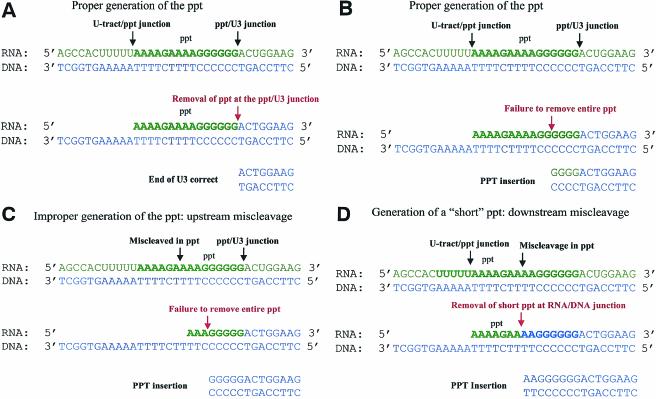FIG. 5.
Mechanisms of retention of PPT sequences. RNAs are shown in green. DNA is shown in blue. Black arrows represent RNase H cleavages that generate the PPT; red arrows represent RNase H cleavages that remove the PPT. (A) The correct generation and removal of the PPT produce a DNA with the proper end. The RNase H cleavages that generate the PPT are made at the U-tract-PPT junction and the PPT-U3 junction (black arrows). The 3′ end of the PPT RNA segment is used to initiate positive-strand DNA synthesis. RNase H removes the PPT at the PPT-U3 junction (red arrow). (B) Failure to remove the entire PPT leads to a complete (or partial) PPT insertion at the 2-LTR circle junction. The RNase H cleavages that generate the PPT occur at the U-tract-PPT junction and the PPT-U3 junction (black arrows). RNase H fails to remove the PPT at the PPT-U3 junction but cleaves within the PPT itself (red arrow). (C) Improper generation of the 5′ end of the PPT can lead to a PPT insertion. The cleavage reactions that generate the PPT occur downstream of the U-tract-PPT junction (black arrow). As a consequence, RNase H fails to remove the entire PPT (red arrow). (D) Generation of a short PPT (3′ miscleavage) leads to PPT insertion at the 2-LTR circle junction. The 5′ end of the PPT is generated at the U-tract-PPT junction; however, the 3′ end is cleaved upstream of the PPT-U3 junction. The primer is shorter than the correct primer. The short primer is used to initiate positive-strand DNA synthesis and is then removed at the RNA-DNA junction (red arrow), leading to a PPT insertion.

